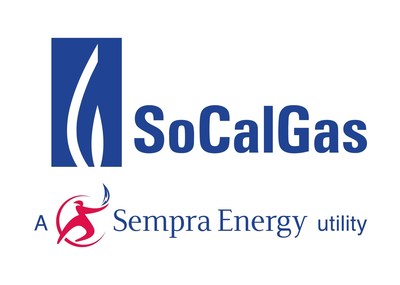LOS ANGELES, April 13, 2015 /PRNewswire/ -- Southern California Gas Company (SoCalGas) is bringing sci-fi innovation to life and has joined with the Energy Department's National Renewable Energy Laboratory (NREL) and the National Fuel Cell Research Center (NFCRC) to launch demonstration projects to create and test a carbon-free, power-to-gas system for the first time ever in the U.S. The technology converts electricity into gaseous energy and could provide North America with a large-scale, cost-effective solution for storing excess energy produced from renewable sources.
Using electrolyzer-based methods, the power-to-gas concept uses electricity from renewable sources, such as solar and wind power, to make carbon-free hydrogen gas by breaking down water into hydrogen and oxygen. The hydrogen can then be converted to synthetic, renewable methane — traditional natural gas — and stored to meet future energy needs. It can also be used as a multi-purpose energy source for vehicles, micro-turbines, fuel cells or other equipment.
"A power-to-gas system can help California meet environmentally-focused energy goals and solve a major energy challenge facing our nation: how to cost-effectively store excess power from renewables to meet energy demands when the wind does not blow or the sun does not shine," said Patrick Lee, senior vice president, customer service, innovation and business strategy for SoCalGas.
California is expected to produce 33 percent of its electricity from renewable sources within five years and Gov. Jerry Brown's new energy goals call for significantly increasing that level to 50 percent by 2030. As the amount of power produced from renewable resources increases, storing it for later use is a worldwide challenge. Batteries, a standard form of storage, require significant capital investment, but have limited capacity and relatively short duration.
Commercial-scale power-to-gas systems are already used in Germany and are being explored globally as a means to convert and store increasing levels of wind and solar power during times of excess supply. Such a commercial system could enable natural gas utilities across North America to use their existing pipeline infrastructure as essentially a large, cost-effective "battery" to store and deliver clean, renewable energy on demand.
Located at the NFCRC at the University of California, Irvine and NREL's laboratories in Golden, Colorado, the power-to-gas demonstrations will also assess the feasibility and potential benefits of using the natural gas pipeline system to store photovoltaic and wind-produced energy.
"As we reach high levels of renewable energy on the grid, storing the electricity generated by solar power and other variable energy sources will help unlock greater use of these renewable resources in the U.S. and throughout the world," said Dr. Martha Symko-Davies, the Director of Partnerships for Energy Systems Integration for NREL. "This project will examine a unique way to reduce the capital cost of energy storage."
While much attention has been focused on developing batteries to store excess energy, battery capabilities are still limited to short-term storage and batteries remain expensive. Power-to-gas offers longer term storage capacity and cost-effectively using existing natural gas infrastructure to potentially create the world's largest storage technology. In addition, power-to-gas storage can conserve the significant amount of energy currently wasted when renewable production exceeds consumption.
"With the extensive storage capacity of natural gas infrastructure, this project will provide important validation of the technical and economic feasibility of carbon-free energy transformation and storage," said Professor Scott Samuelsen, director of the NFCRC.
"SoCalGas continually seeks innovation to benefit our customers and is excited to work with NREL and NFCRC to help make this technology a reality in the U.S.," added Lee.
SoCalGas' power-to-gas project is expected to provide valuable data on the dynamics of hydrogen production in a system flush with renewable electricity. Initial project results are expected by year end.
About SoCalGas: Southern California Gas Co. has been delivering clean, safe and reliable natural gas to its customers for more than 140 years. It is the nation's largest natural gas distribution utility, providing service to 21.4 million consumers connected through 5.9 million meters in more than 500 communities. The company's service territory encompasses approximately 20,000 square miles throughout central and Southern California, from Visalia to the Mexican border. Southern California Gas Co. is a regulated subsidiary of Sempra Energy (NYSE: SRE), a Fortune 500 energy services holding company based in San Diego.
About the National Fuel Cell Research Center:
The National Fuel Cell Research Center (NFCRC) was dedicated in 1998 by the U.S. Department of Energy and the California Energy Commission with the goal to accelerate the development and deployment of advanced fuel cell technology and systems. Examples include the tri-generation of bio-hydrogen, the hybridization of fuel cells with gas turbines, and the deployment of hydrogen fueling infrastructure. The NFCRC is located at the University of California, Irvine. For more information visit www.nfcrc.uci.edu.
About the University of California, Irvine: Currently celebrating its 50th anniversary, UCI is the youngest member of the prestigious Association of American Universities. Founded in 1965, UC Irvine is ranked first among U.S. universities under 50 years old by the London-based Times Higher Education. The campus has produced three Nobel laureates and is known for its academic achievement, premier research, innovation and anteater mascot. Led by Chancellor Howard Gillman, UCI has more than 30,000 students and offers 192 degree programs. It's located in one of the world's safest and most economically vibrant communities and is Orange County's second-largest employer, contributing $4.8 billion annually to the local economy. For more on UCI, visit www.uci.edu.

Logo - http://photos.prnewswire.com/prnh/20150126/171209LOGO
SOURCE Southern California Gas Company